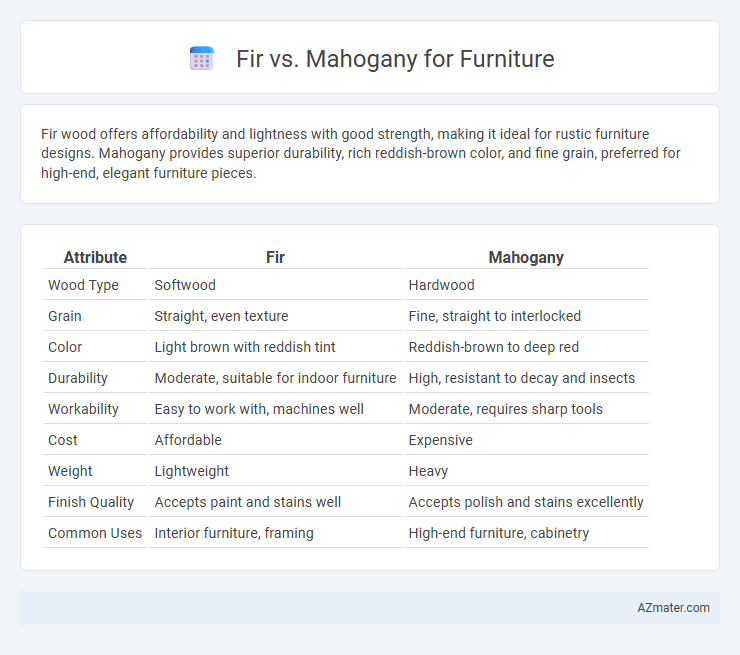Fir wood offers affordability and lightness with good strength, making it ideal for rustic furniture designs. Mahogany provides superior durability, rich reddish-brown color, and fine grain, preferred for high-end, elegant furniture pieces.
Table of Comparison
| Attribute | Fir | Mahogany |
|---|---|---|
| Wood Type | Softwood | Hardwood |
| Grain | Straight, even texture | Fine, straight to interlocked |
| Color | Light brown with reddish tint | Reddish-brown to deep red |
| Durability | Moderate, suitable for indoor furniture | High, resistant to decay and insects |
| Workability | Easy to work with, machines well | Moderate, requires sharp tools |
| Cost | Affordable | Expensive |
| Weight | Lightweight | Heavy |
| Finish Quality | Accepts paint and stains well | Accepts polish and stains excellently |
| Common Uses | Interior furniture, framing | High-end furniture, cabinetry |
Introduction: Fir vs Mahogany in Furniture Making
Fir wood offers durability and affordability, making it a popular choice for sturdy furniture pieces. Mahogany is prized for its rich color, smooth grain, and resistance to decay, often used in high-end, elegant furniture. Selecting between fir and mahogany depends on desired aesthetics, budget, and the furniture's intended use.
Wood Characteristics: Fir and Mahogany Compared
Fir wood is lightweight with a straight grain and pale color, making it easy to work with and ideal for structural furniture components. Mahogany features a rich reddish-brown hue, fine grain, and excellent durability, prized for its smooth finish and resistance to decay. Both woods differ in hardness and aesthetics, with fir offering affordability and mahogany delivering luxury and longevity in furniture design.
Appearance and Grain Differences
Fir wood features a light color with a straight, even grain that often presents a smooth, uniform surface ideal for modern or minimalist furniture designs. Mahogany stands out with its rich, reddish-brown hue and exceptionally fine, interlocking grain patterns that create a luxurious, classic look favored in high-end and traditional furniture. The contrasting grain textures--Fir's simplicity against Mahogany's intricate swirls--make each wood type uniquely suited to different aesthetic preferences and interior styles.
Strength and Durability
Fir wood offers moderate strength and durability, making it suitable for indoor furniture that doesn't require heavy load-bearing capacity. Mahogany, renowned for its exceptional hardness and resistance to decay, provides superior durability ideal for both indoor and outdoor furniture applications. Its dense grain structure ensures longevity and the ability to withstand wear and environmental factors better than fir.
Workability and Ease of Crafting
Fir wood offers excellent workability, making it a preferred choice for beginners and craftsmen looking for easy shaping and cutting due to its straight grain and soft texture. Mahogany, while denser and harder, provides superior durability and a smooth finish when properly worked, though it requires more skill and sharper tools for intricate carving and detailed designs. Both woods excel in furniture making, but Fir excels in ease of crafting whereas Mahogany is favored for high-end, finely crafted pieces.
Cost Comparison: Affordability and Value
Fir wood offers a more affordable option for furniture compared to mahogany, with prices typically lower due to its faster growth rate and abundant availability. Mahogany, prized for its rich color and durability, commands higher prices but often provides greater long-term value through its resistance to wear and aging. Choosing fir balances initial cost savings with decent strength, while mahogany invests in premium quality and lasting elegance.
Resistance to Decay and Insects
Mahogany offers superior resistance to decay and insect damage compared to fir, making it a durable choice for long-lasting furniture. Fir is more prone to rot and termite infestation, requiring additional treatments to enhance its durability. Choosing mahogany ensures furniture maintains structural integrity in varying environmental conditions due to its natural oils and dense grain.
Sustainability and Environmental Impact
Fir wood, sourced from fast-growing coniferous trees, offers a more sustainable option for furniture due to its rapid regeneration and lower environmental footprint compared to mahogany. Mahogany, prized for its durability and rich color, often comes from slower-growing tropical hardwood forests, raising concerns over deforestation and biodiversity loss. Choosing fir supports sustainable forestry practices and reduces ecological impact, making it a greener choice for eco-conscious furniture production.
Best Uses: Recommended Furniture Types
Fir wood is ideal for construction-oriented furniture such as shelves, beds, and tables due to its strength and affordability. Mahogany excels in fine furniture pieces like cabinets, dining tables, and intricate carvings thanks to its rich color, durability, and smooth grain. Choosing fir works best for functional, rustic styles, whereas mahogany suits elegant, high-end designs.
Conclusion: Choosing Between Fir and Mahogany
Fir offers affordability and structural strength, making it ideal for budget-friendly, durable furniture, while mahogany boasts rich color, fine grain, and exceptional durability suitable for high-end, elegant pieces. Selecting fir suits functional, everyday furniture with a lighter aesthetic, whereas mahogany enhances luxury designs requiring long-lasting beauty. Ultimately, the decision hinges on balancing cost, appearance, and intended furniture use.

Infographic: Fir vs Mahogany for Furniture
 azmater.com
azmater.com